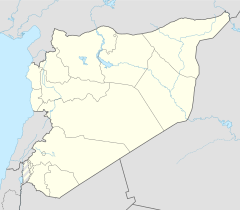Qasr al-Hayr al-Gharbi
| Qasr al-Hayr al-Gharbi قصر الحير الغربي | |
|---|---|
 Qasr al-Heer al-Gharbi facade | |
 Location within Syria | |
| General information | |
| Town or city | Homs Governorate |
| Country | Syria |
| Coordinates | 34°22′28″N 37°36′21″E / 34.374444°N 37.605833°E |
Qasr al-Hayr al-Gharbi (Arabic: قصر الحير الغربي) is a Syrian desert castle or qasr located 80 km south-west of Palmyra on the Damascus road. The castle is a twin palace of Qasr al-Hayr al-Sharqi, built by the Umayyad caliph Hisham ibn Abd al-Malik in 727 CE. It was built in the Umayyad architectural style.
Description[]

Qasr al-Hayr al-Gharbi is one of a number of Umayyad desert castles in the Syrian/Jordanian region. The site originally consisted of a palace complex, a bath house, industrial buildings for the production of olive oil, an irrigated garden and another building which scholars suggest may have been a caravanserai. Over the entrance is an inscription which declares that it was built by Hisham in the year 727, a claim that is borne out by the architectural style.[1]
It was used as an eye of the king during the Umayyad era, to control the movement of the desert tribes and to act as a barrier against marauding tribes, as well as serving a hunting lodge. It is one of the most luxurious examples of a desert palace.[2] Later it was utilized by the Ayyubids and the Mamelukes but was abandoned permanently after the Mongol invasions.
The castle is quadrangular in outline with 70-meter sides. The central doorway to the castle is very attractive and has been moved to the National Museum of Damascus to be used as the entrance. Its semi-cylindrical towers on the sides of the doorway, columns, and the geometric shapes mirrored a blend of Persian, Byzantine and Arab architecture.[3]
Little of the original castle remains; however, the reservoir to collect water from Harbaka dam, a bath and a khan are still visible. The gateway is preserved as a façade in the National Museum of Damascus.
See also[]
References[]
External links[]
| Wikimedia Commons has media related to Qasr al-Heir al-Gharbi. |
- "Qasr Al Hir". Syria Gate. Archived from the original on 2007-11-18.
- Genequand, Denis (2013). "Some Thoughts on Qasr al-Hayr al-Gharbi, its Dam, its Monastery and the Ghassanids". Levant. 38 (1): 63–84. doi:10.1179/lev.2006.38.1.63. ISSN 0075-8914.
Coordinates: 34°22′28″N 37°36′21″E / 34.37444°N 37.60583°E
- 8th-century fortifications
- Umayyad palaces
- Umayyad architecture
- Castles in Syria
- Buildings and structures in Homs Governorate
- Palaces in Syria
- 8th-century establishments in the Umayyad Caliphate
- Buildings and structures completed in 727


